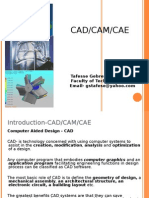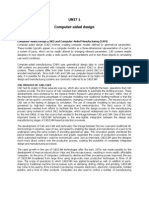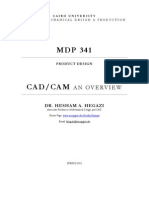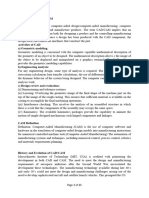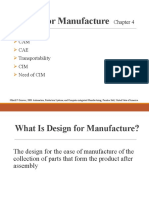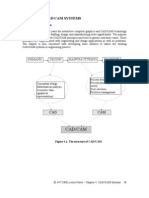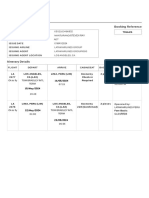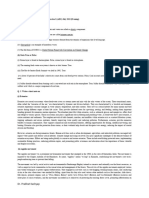DO Seminar Report
DO Seminar Report
Uploaded by
Mithun N Gowda ME-MD-2019-21Copyright:
Available Formats
DO Seminar Report
DO Seminar Report
Uploaded by
Mithun N Gowda ME-MD-2019-21Original Description:
Original Title
Copyright
Available Formats
Share this document
Did you find this document useful?
Is this content inappropriate?
Copyright:
Available Formats
DO Seminar Report
DO Seminar Report
Uploaded by
Mithun N Gowda ME-MD-2019-21Copyright:
Available Formats
A SEMINAR REPORT
on
IMPACT OF CAE ON DESIGN
Submitted by
Mithun N (1BY19MMD02)
Partial fulfilment for the award of the degree of
Master of Technology in Machine Design(II Sem)
COURSE: DESIGN OPTIMIZATION (18CAE251)
DEPARTMENT OF MECHANICAL ENGINEERING
BMS INSTITUTE OF TECHNOLOGY AND MANAGEMENT
Avalahalli, Doddaballapur Main Road, Bengaluru-560064
IMPACT OF CAE ON DESIGN
ABSTRACT
IMPACT OF CAE ON DESIGN
Computer aided engineering (CAE) is an analysis performed at the computer
terminal using a CAD system. It includes computer-aided design (CAD), computer-aided
analysis (CAA), computer-integrated manufacturing (CIM), computer-aided manufacturing
(CAM), material requirements planning (MRP), and computer-aided planning (CAP). Its
purpose is mainly to analyze the different materials, products, their performance and quality,
such as durability, stability, etc. It has many advantages like improved safety and product
quality, reduced product cost, customer satisfaction, etc. and so it has many applications like
used to analyze the properties of material, commercial and flight simulations, etc. It has 3
phases: pre-processing, analysis solver, post- processing of results.
CAE is mainly of 3 types: finite element analysis (FEA), computational fluid
dynamics (CFD), and Boundary Element Analysis (BEA). FEA is used to conduct static and
dynamic analysis. CFD is used to optimize components for efficient fluid flow and heat
transfer. BEA is used to predict noise characteristics on various systems.
IMPACT OF CAE ON DESIGN
TABLE OF CONTENTS
CHAPTER NO. TITLE PAGE NO
Abstract
1. INTRODUCTION 1
2. CONCEPT AND DEFINITION 2-5
3. GOALS OF COMPUTER AIDED ENGINEERING 6
4. PHASES OF CAE 7-13
5. BENEFITS OF CAE 13
6. CONCLUSION 14
IMPACT OF CAE ON DESIGN
IMPACT OF CAE ON DESIGN
1. INTRODUCTION
The future success of a manufacturing enterprise is likely to be determined by
the speed and efficiency with which it incorporates new technologies into its operations. The
process which is currently used to engineer, or re-engineer, manufacturing systems is often ad
hoc. Computerized tools are used on a very limited basis. Given the costs and resources
involved in the construction and operation of manufacturing systems, the engineering process
must be made more scientific. Powerful new computing environments for engineering
manufacturing systems could help achieve that objective.
Today, Computer Aided Engineering (CAE) technology contributes decisively
to shortening and optimizing product development cycles in many fields of industry and
research. Computer aided analysis and simulation enables our customers to assess and test the
behaviour of future components, products and processes by subjecting them to a range of
computer simulated physical conditions. This leads to savings in both the time and money
which would have been spent on cost-intensive test runs without any loss in quality and opens
up new possibilities for innovation. Computer aided engineering (CAE) retrieves description
and geometry from a computer aided manufacturing (CAD) database. Computer aided
engineering (CAE) is an analysis performed at the computer terminal using a CAD system.
Thus, software tools that have been developed to support the activities in computer analysis
are considered CAE tools. CAE tools are being used, for example, to analyze the robustness
and performance of components and assemblies. The term encompasses simulation,
validation, and optimization of products and manufacturing tools. In the future, CAE systems
will be major providers of information to help support design teams in decision making. In
regard to information networks, CAE systems are individually considered a single node on a
total information network and each node may interact with other nodes on the network. CAE
systems can provide support to businesses. This is achieved by the use of reference
architectures and their ability to place information views on the business process. Reference
architecture is the basis from which information model, especially product and manufacturing
models. The term CAE has also been used by some in the past to describe the use of
computer technology within engineering in a broader sense than just engineering analysis.
IMPACT OF CAE ON DESIGN 1
2. CONCEPT AND DEFINITION
2.1 ORIGIN OF CAE:
Historically, engineers analyzed designs by building and testing physical
prototypes, performing calculations by hand or with some computing aid such as a slide rule.
They frequently used tabulated mathematical functions, approximation methods, and data
accumulated from previous experience and physical testing to simplify their analyses. Some
analyses were so time-consuming that, when done at all, they could be completed only for
one simplified example. This frequently led to under- and over-designed systems. The first
case resulted in systems that did not work properly or failed outright. In the second case, the
systems were more expensive than necessary or too heavy to meet their goals. Physical
prototypes were (and remain) very costly and time-consuming to build and test and they often
have to be recreated as designs are changed. The advent of analog and digital computers
provided engineers with systems capable of analyzing designs much more quickly and
allowed them to undertake analyses that were previously impractical to attempt. However,
early computer systems were too slow and limited in capacity (memory, storage, I/O speed)
to handle extremely large or complex mechanical systems. While they provided a base for
new, more extensive design evaluations, many of the historical problems remained and new
problems arose. These included limited access to expensive, high powered computing
systems and difficulties describing the physical form of designs in a way that computers
could work with them efficiently. Therefore, many early analysis programs used
unrealistically simplified, schematic-like descriptions of the physical system. It was
impossible to describe any but the simplest system’s geometry within the computing
environment.
Then came the creation of CAD/ CAM systems by the aerospace industry in
the early 1960s to assist with the massive design and documentation tasks associated with
producing airplanes. By the late 1970s, these codes were being distributed to other industries.
CAD/CAM systems have been used primarily for detail design and drafting along with the
generation of numerical control instructions for manufacturing. Gradually, more CAE
functions are being added to CAD/CAM systems. A trend toward open architecture with
flexible geometry interfaces is stimulating the addition of more analysis and manufacturing
functions. Modelling with CAD/CAM systems has become fairly sophisticated. Most popular
IMPACT OF CAE ON DESIGN 2
commercial systems support 2D and 3D wireframe, surface models, and solid models.
2.2 DEFINITON OF CAE:
Computer aided engineering (CAE) is an analysis performed at the computer
terminal using a CAD system. It includes computer-aided design (CAD), computer-aided
analysis (CAA), computer-integrated manufacturing (CIM), computer-aided manufacturing
(CAM), material requirements planning (MRP), and computer-aided planning (CAP). CAE
mainly depends on CAD. It is usually used in every industry such as aerospace, automobile
industry.
Flow diagram for a computer aided engineering
Computer-aided design (CAD), also known as computer-aided design and
drafting (CADD),[1] is the use of computer technology for the process of design and design-
documentation. Computer Aided Drafting describes the process of drafting with a computer.
CADD software provides the user with input-tools for the purpose of streamlining design
processes; drafting, documentation, and manufacturing processes. CADD output is often in
the form of electronic files for print or machining operations. CADD software uses either
vector-based graphics to depict the objects of traditional drafting, or may also produce raster
graphics showing the overall appearance of designed objects.
IMPACT OF CAE ON DESIGN 3
Computer Integrated Manufacturing (CIM) encompasses the entire range of
product development and manufacturing activities with all the functions being carried out
with the help of dedicated software packages. The data required for various functions are passed
from one application software to another in a seamless manner. For example, the product data
is created during design. This data has to be transferred from the modelling software to
manufacturing software without any loss of data. CIM uses a common database wherever
feasible and communication technologies to integrate design, manufacturing and associated
business functions that combine the automated segments of a factory or a manufacturing
facility. CIM reduces the human component of manufacturing and thereby relieves the
process of its slow, expensive and error-prone component. CIM stands for a holistic and
methodological approach to the activities of the manufacturing enterprise in order to achieve
vast improvement in its performance. This methodological approach is applied to all activities
from the design of the product to customer support in an integrated way, using various
methods, means and techniques in order to achieve production improvement, cost reduction,
fulfillment of scheduled delivery dates, quality improvement and total flexibility in the
manufacturing system.
CIM requires all those associated with a company to involve totally in the process
of product development and manufacture. In such a holistic approach, economic, social and
human aspects have the same importance as technical aspects. CIM also encompasses the
whole lot of enabling technologies including total quality management, business process
reengineering, concurrent engineering, workflow automation, enterprise resource planning
and flexible manufacturing.
Material requirements planning (MRP) is a production planning and
inventory control system used to manage manufacturing processes. Most MRP systems are
software-based, while it is possible to conduct MRP by hand as well. The basic function of
MRP system includes inventory control, bill of material processing and elementary
scheduling. MRP helps organizations to maintain low inventory levels. It is used to plan
manufacturing, purchasing and delivering activities.
IMPACT OF CAE ON DESIGN 4
"Manufacturing organizations, whatever their products, face the same daily
practical problem - that customers want products to be available in a shorter time than it takes
to make them. This means that some level of planning is required." Companies need to
control the types and quantities of materials they purchase, plan which products are to be
produced and in what quantities and ensure that they are able to meet current and future
customer demand, all at the lowest possible cost. Making a bad decision in any of these areas
will make the company lose money.
Computer-aided process planning (CAPP) is the use of computer technology to
aid in the process planning of a part or product, in manufacturing. CAPP is the link between
CAD and CAM in that it provides for the planning of the process to be used in producing a
designed part. Process planning is concerned with determining the sequence of individual
manufacturing operations needed to produce a given part or product. The resulting operation
sequence is documented on a form typically referred to as a route sheet containing a listing of
the production operations and associated machine tools for a workpart or assembly. Process
planning in manufacturing also refers to the planning of use of blanks, spare parts, packaging
material, user instructions (manuals) etc. Process planning translates design information into
the process steps and instructions to efficiently and effectively manufacture products. As the
design process is supported by many computer-aided tools, computer-aided process planning
(CAPP) has evolved to simplify and improve process planning and achieve more effective
use of manufacturing resources.
IMPACT OF CAE ON DESIGN 5
3. GOALS OF COMPUTER AIDED ENGINEERING
The goals of computer-aided engineering (CAE) are:
improved product quality
improved safety
reduced engineering time, achieved through fewer design iterations
improved product functionality and usability
reduced number of prototypes, ultimately leading to their elimination in many cases
reduced product cost.
These goals has helped computer aided engineering to achieve various heights like:
CAE can be used to perform variety tests like car crash the test simulation
Can be used for Commercial and military flight simulations
It is also used to analyze properties of different types material used in production
application of computerized methods during the design of technical systems
It increases production efficiency and quality through better designs
It is also a Tool for decision making-what the product is going to look like, its
performance characteristics, what improvements need to be made?
CAD analysis on be done on the computer screen
There is no need to build products’ prototypes
Results of analysis is essential and can be saved for future of the product
Customer satisfaction is priority and can be achieved through CAE
CAE has to be compliant with many U.S. and international standards and so the product
real-world performance and safety is achieved.
It also provide the customers with a concept before building expensive prototypes and
pre-production units and hence customer satisfaction can be achieved.
IMPACT OF CAE ON DESIGN 6
4. PHASES OF CAE
CAE applications support a wide range of engineering disciplines or phenomena including:
Stress and dynamics analysis on components and assemblies using finite element
analysis (FEA)
Thermal and fluid analysis using computational fluid dynamics (CFD)
Kinematics and dynamic analysis of mechanisms (multi body dynamics)
In general, there are three phases in any computer-aided engineering task:
Pre-processing – defining the model and environmental factors to be applied to it. It is
typically a finite element model, but facet, voxel and thin sheet methods are also used in
this phase.
Analysis solver- it is usually performed on high powered computers.
Post-processing of results – it is the last phase in any computer aided engineering task
and is done using visualization tools.
4.1 FINITE ELEMENT ANALYSIS:
The finite element method (FEM ) (its practical application often known as
finite element analysis (FEA)) is a numerical technique for finding approximate solutions
of partial differential equations (PDE) as well as integral equations. The solution
approach is based either on eliminating the differential equation completely (steady state
problems), or rendering the PDE into an approximating system of ordinary differential
equations, which are then numerically integrated using standard techniques such as
Euler's method, Runge-Kutta, etc.
In solving partial differential equations, the primary challenge is to create an
equation that approximates the equation to be studied, but is numerically stable, meaning that
errors in the input and intermediate calculations do not accumulate and cause the resulting
IMPACT OF CAE ON DESIGN 7
output to be meaningless. There are many ways of doing this, all with advantages and
disadvantages. The finite element method is a good choice for solving partial differential
equations over complicated domains (like cars and oil pipelines), when the domain changes
(as during a solid state reaction with a moving boundary), when the desired precision varies
over the entire domain, or when the solution lacks smoothness. For instance, in a frontal crash
simulation it is possible to increase prediction accuracy in "important" areas like the front of
the car and reduce it in its rear (thus reducing cost of the simulation). Another example would
be in Numerical weather prediction, where it is more important to have accurate predictions
over developing highly-nonlinear phenomena (such as tropical cyclones in the atmosphere,
or eddies in the ocean) rather than relatively calm areas.
Example for finite element analysis
APPLICATION OF FINITE ELEMENT ANALYSIS:
A variety of specializations under the umbrella of the mechanical engineering
discipline (such as aeronautical, biomechanical, and automotive industries) commonly use
integrated FEM in design and development of their products. Several modern FEM packages
include specific components such as thermal, electromagnetic, fluid, and structural working
environments. In a structural simulation, FEM helps tremendously in producing stiffness and
strength visualizations and also in minimizing weight, materials, and costs. FEM allows
detailed visualization of where structures bend or twist, and indicates the distribution of
stresses and displacements. FEM software provides a wide range of simulation options for
controlling the complexity of both modelling and analysis of a system. Similarly, the desired
level of accuracy required and associated computational time requirements can be managed
simultaneously to address most engineering applications. FEM allows entire designs to be
constructed, refined, and optimized before the design is manufactured.
This powerful design tool has significantly improved both the standard of
engineering designs and the methodology of the design process in many industrial
IMPACT OF CAE ON DESIGN 8
applications. The introduction of FEM has substantially decreased the time to take products
from concept to the production line. It is primarily through improved initial prototype designs
using FEM that testing and development have been accelerated. In summary, benefits of
FEM include increased accuracy, enhanced design and better insight into critical design
parameters, virtual prototyping, fewer hardware prototypes, a faster and less expensive design
cycle, increased productivity, and increased revenue.
4.2 BOUNDARY ELEMENT ANALYSIS:
The boundary element method (BEM) is a numerical computational method of
solving linear partial differential equations which have been formulated as integral equations
(i.e. in boundary integral form). It can be applied in many areas of engineering and science
including fluid mechanics, acoustics, electro-magnetic, and fracture mechanics. The integral
equation may be regarded as an exact solution of the governing partial differential equation.
The boundary element method attempts to use the given boundary conditions to fit boundary
values into the integral equation, rather than values throughout the space defined by a partial
differential equation. Once this is done, in the post-processing stage, the integral equation can
then be used again to calculate numerically the solution directly at any desired point in the
interior of the solution domain.
BEM is applicable to problems for which Green's functions can be calculated.
These usually involve fields in linear homogeneous media. This places considerable
restrictions on the range and generality of problems to which boundary elements can usefully
be applied. Nonlinearities can be included in the formulation, although they will generally
introduce volume integrals which then require the volume to be discretised before solution
can be attempted, removing one of the most often cited advantages of BEM
The boundary element method is often more efficient than other methods,
including finite elements, in terms of computational resources for problems where there is a
[1]
small surface/volume ratio . Conceptually, it works by constructing a "mesh" over the
modelled surface. However, for many problems boundary element methods are significantly
less efficient than volume-discretization methods. Boundary element formulations typically
give rise to fully populated matrices. This means that the storage requirements and
computational time will tend to grow according to the square of the problem size. By
contrast, finite element matrices are typically banded (elements are only locally connected)
IMPACT OF CAE ON DESIGN 9
and the storage requirements for the system matrices typically grow quite linearly with the
problem size. Compression techniques (e.g. multipole expansions or adaptive cross
approximation/hierarchical matrices) can be used to ameliorate these problems, though at the
cost of added complexity and with a success-rate that depends heavily on the nature of the
problem being solved and the geometry involved.
4.3 COMPUTATIONAL FLUID DYNAMICS:
Computational fluid dynamics, usually abbreviated as CFD, is a branch of
fluid mechanics that uses numerical methods and algorithms to solve and analyze problems
that involve fluid flows. Computers are used to perform the calculations required to simulate
the interaction of liquids and gases with surfaces defined by boundary conditions. With high-
speed supercomputers, better solutions can be achieved. Ongoing research yields software
that improves the accuracy and speed of complex simulation scenarios such as transonic or
turbulent flows. Initial validation of such software is performed using a wind tunnel with the
final validation coming in full-scale testing, e.g. flight tests. The fundamental basis of almost
all CFD problems are the Navier–Stokes equations, which define any single- phase fluid
flow. These equations can be simplified by removing terms describing viscosity to yield the
Euler equations.
Further simplification, by removing terms describing vorticity yields the full
potential equations. Finally, these equations can be linearized to yield the linearized potential
equations.
In this approach, these procedures are followed:
During preprocessing
The geometry (physical bounds) of the problem is defined.
The volume occupied by the fluid is divided into discrete cells (the mesh). The mesh
may be uniform or non uniform.
The physical modeling is defined – for example, the equations of motions
+ enthalpy + radiation + species conservation
Boundary conditions are defined. This involves specifying the fluid behaviour and
properties at the boundaries of the problem. For transient problems, the initial
IMPACT OF CAE ON DESIGN 10
conditions are also defined.
The simulation is started and the equations are solved iteratively as a steady-state
or transient.
Finally, a postprocessor is used for the analysis and visualization of the resulting solution.
4.4 KINEMATIC AND DYNAMIC ANALYSIS:
"Motion study" is a catch-all term for simulating and analyzing the movement
of mechanical assemblies and mechanisms. Traditionally, motion studies have been divided
into two categories: kinematics and dynamics. Kinematics is the study of motion without
regard to forces that cause it; dynamics is the study of motions that result from forces. Other
closely related terms for the same types of studies are multibody dynamics, mechanical
system simulation, and even virtual prototyping. Kinematic analysis is a simpler task than
dynamic analysis and is adequate for many applications involving moving parts. Kinematic
simulations show the physical positions of all the parts in an assembly with respect to the
time as it goes through a cycle. This technology is useful for simulating steady-state motion
(with no acceleration), as well as for evaluating motion for interference purposes, such as
assembly sequences of complex mechanical system. Many basic kinematic packages,
however, go a step further by providing "reaction forces," forces that result from the motion.
Dynamic simulation is more complex because the problem needs to be further
defined and more data is needed to account for the forces. But dynamics are often required to
accurately simulate the actual motion of a mechanical system. Generally, kinematic
simulations help evaluate form, while dynamic simulations assist in analyzing function.
Traditionally, kinematics and dynamics have followed the classic analysis software method
of preprocessing (preparing the data), solving (running the solution algorithms, which involve
the solution of simultaneous equations), and post processing (analyzing the results). Even
though today's programs are much more interactive, most programs follow this basic process
since it is a logical way to solve the problem. Most solvers are available as independent
software programs. The basic output of motion studies is numerous, including animation,
detecting interference, trace functions, basic motion data, and plots and graphs. Animated
motions are the classic output of simple kinematic analyses. Initially, the designer uses
simple animation as a visual evaluation of motion to see if it is what is desired. More
sophisticated animations can show motion from critical angles or even inside of parts, a
IMPACT OF CAE ON DESIGN 11
definite advantage over building and running a physical prototype. The ability to detect and
fix interferences without switching between software is one of the primary benefits of
integrating motion simulation and CAD.
Most systems provide colour feedback, for example, by turning to red parts
that experience interferences. More useful, however, are systems that turn the interference
volume into a separate piece of geometry, which can then be used to modify the parts to
eliminate the interference. Trace functions provide additional information about motion. The
motion of a joint or a particular point on a part can be plotted in 3D as a line or surface. Or,
the system can leave copies of the geometry at specified intervals. Such functions can provide
an envelope of movement that can be used to design housings or ensure clearances. Motion
data, such as forces, accelerations, velocities, and the exact locations of joints or points on
geometry can usually be extracted, although such capabilities are more applicable to dynamic
simulations rather than kinematic studies. Some systems allow users to attach instruments to
their models to simplify specifying what results they want to see. Most packages provide a
plethora of plotting and graphing functions.
Plots and graphs are most commonly used because values vary over time and
are more meaningful than a single value at any given time. An especially useful capability for
studying design alternatives is to plot the results of two different simulations on the same
graph. Such data can also help designers determine the size of motors, actuators, springs, and
other mechanism components.
Forces that result from motion are of particular interest because they can be
used as loads (or, at least, to calculate them) for structural analysis of individual members.
Typically, the highest load for a cycle is used to perform a linear static finite element analysis
(FEA) of critical individual components of a mechanism. Integration of solid modelling,
motion simulation, and FEA software can greatly streamline this process—especially
IMPACT OF CAE ON DESIGN 12
important when studying design alternatives, where many analyses are required.
5. BENEFITS OF CAE
The benefits of CAE are:
Designs decision can be made based on their impact on performance.
Designs can be evaluated and refined using computer simulation rather than physical
prototype testing, saving money and time.
CAE can provide performance insights earlier in the development process, when design
changes are less expensive to make.
CAE helps engineering teams to manage risk and understand the performance
implications of their designs.
Integrated CAE data and process management extends the ability to effectively leverage
performance insights and improve designs to a broader community.
6. CONCLUSION
CAE is an analysis entirely done on computer using CAD systems. Its purpose
is to analyze different materials, products, their performance and quality such as durability,
stability, endurance and/or reactivity to any possible factor that can affect the performance of
the material, part, and/or the product. A typical CAE process comprises of pre-processing,
solving, and post-processing steps. In the pre-processing phase, engineers model the geometry
and the physical properties of the design, as well as the environment in the form of applied
loads or constraints. Next, the model is solved using an appropriate mathematical formulation
of the underlying physics. In the post-processing phase, the results are presented to the
IMPACT OF CAE ON DESIGN 13
engineer for review. The analysis of CAE consists of mainly 4 methods like finite element
analysis, computational fluid dynamics, boundary element analysis, kinematic and dynamic
analysis. It has many advantages like its cost saving and ensures customer satisfaction and
improves the speed, efficiency and the quality of many products ranging from simple parts to
vehicles, airplanes etc. Designs can be evaluated and refined using computer simulations. Its
applications include control systems analysis, simulation of manufacturing processes like
casting, moulding and die press forming, Optimization of the product or process and mems.
REFERENCES
CAD/CAM/CIM by P.Radhakrishnan, 3rd edition, New Age International publications
Fundamentals of computer aided engineering, by B.Raphael and I.F.C. Smith,
Wiley publishers
http://www.roushind.com/html/cae.html
http://www.computeraidedengineering.com
http://www.fea-online.com
http://www.marc.com
http://www.optem.com
http://www.ece.curtin.edu.au
http://kernow.curtin.edu.au/cae.html
www.stadco.co.in
IMPACT OF CAE ON DESIGN 14
You might also like
- Due Diligence Checklist Real EstateDocument33 pagesDue Diligence Checklist Real Estatevhkprasad100% (4)
- Google Cloud Platform for Data Engineering: From Beginner to Data Engineer using Google Cloud PlatformFrom EverandGoogle Cloud Platform for Data Engineering: From Beginner to Data Engineer using Google Cloud PlatformRating: 5 out of 5 stars5/5 (1)
- Amazon Invoice - HDMI To VGA With AudioDocument1 pageAmazon Invoice - HDMI To VGA With AudioAl-Harbi Pvt LtdNo ratings yet
- Introduction To CAD/CAMDocument81 pagesIntroduction To CAD/CAMTafesse100% (7)
- CAD CAM PresentationDocument27 pagesCAD CAM Presentationanon_877650732100% (7)
- The New 3D Layout for Oil & Gas Offshore Projects: How to ensure successFrom EverandThe New 3D Layout for Oil & Gas Offshore Projects: How to ensure successRating: 4.5 out of 5 stars4.5/5 (3)
- SeminarDocument23 pagesSeminarAchu KuttyNo ratings yet
- Universiti Kuala Lumpur Malaysian Institute of Marine Engineering Technology (Unikl Mimet)Document14 pagesUniversiti Kuala Lumpur Malaysian Institute of Marine Engineering Technology (Unikl Mimet)Haiqal MarizanNo ratings yet
- A ReportDocument8 pagesA ReportTyNo ratings yet
- AM Unit 2 NotesDocument25 pagesAM Unit 2 NotesNikhil Sahu MechanicalNo ratings yet
- Cybercut: An Internet-Based Cad/Cam SystemDocument33 pagesCybercut: An Internet-Based Cad/Cam SystemJitendra JainNo ratings yet
- The Role of Computer Aided Design (CAD) in The Manufacturing and Digital Control (CAM)Document16 pagesThe Role of Computer Aided Design (CAD) in The Manufacturing and Digital Control (CAM)Paddy Nji KilyNo ratings yet
- Computer Aided Progressive Die DesignDocument2 pagesComputer Aided Progressive Die DesignDeep AhireNo ratings yet
- PMT 302 Fundamentals of Industrial Technology 2024 - 2 UnitsDocument10 pagesPMT 302 Fundamentals of Industrial Technology 2024 - 2 Unitswisdomalexjust18No ratings yet
- Wa0058 PDFDocument15 pagesWa0058 PDFkoustav4workNo ratings yet
- Development of An Integrated Laser-Based Reverse Engineering and Machining SystemDocument6 pagesDevelopment of An Integrated Laser-Based Reverse Engineering and Machining SystemAmrik SinghNo ratings yet
- Computer-Aided Engineering (CAE) Is The Broad Usage of ComputerDocument4 pagesComputer-Aided Engineering (CAE) Is The Broad Usage of ComputerDavid AlexNo ratings yet
- Computer-Aided Engineering - WikipediaDocument3 pagesComputer-Aided Engineering - Wikipediaramthecharm_46098467No ratings yet
- Experiment No. 1: AIM: To Study About CAD, CAM and CAE Software and Its AdvantagesDocument8 pagesExperiment No. 1: AIM: To Study About CAD, CAM and CAE Software and Its AdvantagessuryavigneNo ratings yet
- Chapter 7: Process PlanningDocument6 pagesChapter 7: Process Planningஅன்புடன் அஸ்வின்No ratings yet
- Cad Cam NotesDocument21 pagesCad Cam NotesarivaazhiNo ratings yet
- Report Cad CamDocument10 pagesReport Cad Camالمهندس زاهر بكريNo ratings yet
- Cad-Cam Manual PDFDocument34 pagesCad-Cam Manual PDFM.Saravana Kumar..M.E100% (3)
- 804 Cad Cam Cim (Me-804) Exp. ManualDocument38 pages804 Cad Cam Cim (Me-804) Exp. ManualAnonymous z3RsdPToNo ratings yet
- Computer Aided Process Planning (CAPP)Document30 pagesComputer Aided Process Planning (CAPP)brijkishor2017100% (1)
- Computer Aided Process Planning Full Seminar ReportDocument32 pagesComputer Aided Process Planning Full Seminar ReportSarath Chandran100% (7)
- Major Applications of Computer in Engineering: by Muhammad Bilal Butt Roll Number 07B07-EEDocument7 pagesMajor Applications of Computer in Engineering: by Muhammad Bilal Butt Roll Number 07B07-EEapi-3810648No ratings yet
- Introduction CAEDocument3 pagesIntroduction CAEsachin kanvikarNo ratings yet
- Integration of Computer Integrated Quality Control With Cad-Cam PDFDocument6 pagesIntegration of Computer Integrated Quality Control With Cad-Cam PDFmann singhNo ratings yet
- CADCAMDocument73 pagesCADCAMnyandikajustin57No ratings yet
- Computer Aided Process Planning Technique in Casting Industries An Overview IJERTV2IS2166Document5 pagesComputer Aided Process Planning Technique in Casting Industries An Overview IJERTV2IS2166CPT MechNo ratings yet
- Cad 20S3 2023 72-83Document13 pagesCad 20S3 2023 72-83vipinNo ratings yet
- Design For Manufacture: CAD CAM CAE Transportability CIM Need of CIMDocument50 pagesDesign For Manufacture: CAD CAM CAE Transportability CIM Need of CIMعبدالرحمن سليمانNo ratings yet
- Introduction To Cad - CamDocument51 pagesIntroduction To Cad - CamAleena FarhanNo ratings yet
- Me704 Cim (Cad)Document25 pagesMe704 Cim (Cad)ASHU KNo ratings yet
- Mec4108 CaeDocument33 pagesMec4108 CaeacematovuNo ratings yet
- Latest Trends and Improvements in CADCAM A Review PaperDocument4 pagesLatest Trends and Improvements in CADCAM A Review PaperSachin ShastriNo ratings yet
- Study of Computer Aided Design and Mechanical Design by Computer SoftwareDocument6 pagesStudy of Computer Aided Design and Mechanical Design by Computer SoftwareAmba Lrcfools InfosNo ratings yet
- 8185 26324 1 PBDocument15 pages8185 26324 1 PBnitishdr1231No ratings yet
- Computer Aided Drafting Week 1Document7 pagesComputer Aided Drafting Week 1mosesbala078No ratings yet
- The Application of Pro Engineer in CADCAMDocument9 pagesThe Application of Pro Engineer in CADCAMHafiezul HassanNo ratings yet
- CAD1 AssignmentDocument11 pagesCAD1 AssignmentJohn2jNo ratings yet
- CAD/CAM Means Computer-Aided Design and Computer-Aided Manufacturing. It Is The TechnologyDocument10 pagesCAD/CAM Means Computer-Aided Design and Computer-Aided Manufacturing. It Is The TechnologyRavi SekharNo ratings yet
- CADCAM MinDocument91 pagesCADCAM MinBandi KumarreddyNo ratings yet
- Engineering Drawing. Assignment PDFDocument28 pagesEngineering Drawing. Assignment PDFAsif KhanzadaNo ratings yet
- Cad CamDocument6 pagesCad CamKuldeep SinghNo ratings yet
- InternshipDocument33 pagesInternshipsravankumarNo ratings yet
- United Cadd Solution: Iso 9001: 2015 Certified CompanyDocument26 pagesUnited Cadd Solution: Iso 9001: 2015 Certified CompanySURESHNo ratings yet
- 01 SSCHANI CV CAx PLMDocument7 pages01 SSCHANI CV CAx PLMEr Chinmoy NandaNo ratings yet
- Industry Uses of CADD: Student Learning ObjectivesDocument11 pagesIndustry Uses of CADD: Student Learning ObjectivesMphilipTNo ratings yet
- Product DevelopmentDocument3 pagesProduct Developmentabdullah nadhifNo ratings yet
- CIM Lecture Notes 4Document7 pagesCIM Lecture Notes 4George CamachoNo ratings yet
- CIM Lecture NotesDocument26 pagesCIM Lecture NotesrajesjanaNo ratings yet
- Cad Cam CaeDocument25 pagesCad Cam Caesadananda_pvc100% (1)
- Reverse Engineering and CAE: Masashi ENDODocument6 pagesReverse Engineering and CAE: Masashi ENDORomdhane Ben KhalifaNo ratings yet
- Geometric Modeling: Exploring Geometric Modeling in Computer VisionFrom EverandGeometric Modeling: Exploring Geometric Modeling in Computer VisionNo ratings yet
- Design Automation of Cyber-Physical SystemsFrom EverandDesign Automation of Cyber-Physical SystemsMohammad Abdullah Al FaruqueNo ratings yet
- AutoCAD Electrical 2020 for Electrical Control Designers, 11th EditionFrom EverandAutoCAD Electrical 2020 for Electrical Control Designers, 11th EditionNo ratings yet
- Concept of FedarlismDocument14 pagesConcept of FedarlismSangham reddi Govinda RaoNo ratings yet
- Gas Power Cycle Motor Bakar Soal Motor Jawaban DisiniDocument72 pagesGas Power Cycle Motor Bakar Soal Motor Jawaban DisiniirkaidirfaisNo ratings yet
- 2020 Global Marketing Strategy Report - Kelton Global 2Document17 pages2020 Global Marketing Strategy Report - Kelton Global 2luis_filho_esNo ratings yet
- CDCFIB - Federal Fire Service REJOICE MALCITDocument2 pagesCDCFIB - Federal Fire Service REJOICE MALCITmalcitrejoiceNo ratings yet
- Portable Planer: GHO 6500 - 3 601 E96 0F0Document3 pagesPortable Planer: GHO 6500 - 3 601 E96 0F0Manmohan SharmaNo ratings yet
- AOI Template SECDocument15 pagesAOI Template SECEdison Flores0% (1)
- MAG 5000, 6000 Operation ManualDocument16 pagesMAG 5000, 6000 Operation ManuallauraNo ratings yet
- Corporate PaintingDocument1 pageCorporate PaintingRobin RavagoNo ratings yet
- Dfa Appointment Form 3Document2 pagesDfa Appointment Form 3jomelkenNo ratings yet
- T V NG, Ý Tư NG Cho Bài SpeakingDocument350 pagesT V NG, Ý Tư NG Cho Bài Speakinghtruc3243No ratings yet
- IST/Switch: High-Performance Transaction Processing and SwitchingDocument4 pagesIST/Switch: High-Performance Transaction Processing and Switchingsayed2020No ratings yet
- Distribution DecisionsDocument65 pagesDistribution DecisionsAnisha Adhikari100% (1)
- International Piano Issue 74 July August 2021Document78 pagesInternational Piano Issue 74 July August 2021Andi Groove100% (2)
- Sample Interview Qu. For Investment BankingDocument10 pagesSample Interview Qu. For Investment BankingMayurNo ratings yet
- Sonck 2016Document9 pagesSonck 2016LeonardoMadeira11No ratings yet
- Nitomortar FC (B)Document2 pagesNitomortar FC (B)Mansoor AliNo ratings yet
- WEEK - 12 - MCQ - Attempt Review MGDocument11 pagesWEEK - 12 - MCQ - Attempt Review MG220701101No ratings yet
- Myday Influencers: The Power of Organic Social Media Posts in Marketing Off The Beaten Path DestinationsDocument41 pagesMyday Influencers: The Power of Organic Social Media Posts in Marketing Off The Beaten Path DestinationsCriza Riene SualogNo ratings yet
- December 2023 Current Tit-Bits by OneClass - 28168415 - 2024 - 01 - 11 - 20 - 35Document32 pagesDecember 2023 Current Tit-Bits by OneClass - 28168415 - 2024 - 01 - 11 - 20 - 35sadvachanmishraNo ratings yet
- AccidentsDocument2 pagesAccidentstadaiva100% (2)
- Product Description: AT-XXX17DT-096-CLGA - Maximum Span 200 MDocument4 pagesProduct Description: AT-XXX17DT-096-CLGA - Maximum Span 200 Mmelcieso1959No ratings yet
- Computer Systems Servicing Hazards & Risks: Css TeacherDocument13 pagesComputer Systems Servicing Hazards & Risks: Css TeacherLady Jae ArbesoNo ratings yet
- Transaction Processing SystemDocument2 pagesTransaction Processing SystemMichaela VillanuevaNo ratings yet
- Case Study - Lankayan Island Dive Resort Project1Document8 pagesCase Study - Lankayan Island Dive Resort Project1Don BakerNo ratings yet
- Electronic Ticket Receipt, December 09 For MR STEVEN RAY MANTURANODocument3 pagesElectronic Ticket Receipt, December 09 For MR STEVEN RAY MANTURANOangeloespinoza766No ratings yet
- SUMMER Traning in Tata MotorsDocument59 pagesSUMMER Traning in Tata Motorsabhay_prakash_ranjan100% (6)
- RUFINA LUY LIM, Petitioner, vs. COURT OF APPEALSDocument2 pagesRUFINA LUY LIM, Petitioner, vs. COURT OF APPEALSZACH MATTHEW GALENDEZNo ratings yet
- Question Paper With Solution July 2023 (Eve)Document9 pagesQuestion Paper With Solution July 2023 (Eve)pratima1514No ratings yet



